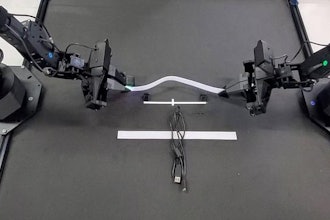Researchers from the Georgia Institute of Technology created a robot designed to be slow and deliberate, like a sloth.
Modeled after the slow, tropical mammals, the SlothBot is a wire-riding, solar-powered robot designed to monitor the environment.
The SlothBot is powered by two photovoltaic panels and designed to continuously measure environmental changes, like the weather or chemicals in the area. It could also be used for infrastructure maintenance, precision agriculture and security applications.
The SlothBot consists of 3D-printed gears as well other components that it uses to cling to wires. It uses these parts to complete basic maneuvers, like switching from wire-to-wire or hanging on in the event of a malfunction.
The robot has two bodies connected by an actuated hinge. Each body has a driving motor connected to a rim on which a tire is mounted. According to the researchers, the wheels are not only simple, but more efficient and safer than other types of wire-based locomotion.
While robot technology has continued to push for faster, more agile and more extreme robots, SlothBot was designed based on the team's "theory of slowness." After all, slow and energy efficient means less down time spent recharging.
The proof-of-concept was presented at the International Conference on Robotics and Automation in Montreal, and could soon be found hanging above the Atlanta Botanical Garden.
Next, the team plans on creating a new 3D-printed enclosure that will not only help protect the onboard camera and other components, but also make it look more like a sloth. I just hope they make sure to give it a creepy smile.






















